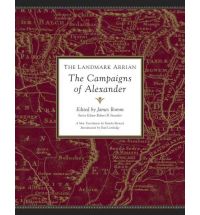By STEVE COATES, The New York Times
THE LANDMARK ARRIAN
The Campaigns of Alexander: Anabasis Alexandrou
Translated by Pamela Mensch
Edited by James Romm
An indelible scene from the life of Alexander the Great finds the prodigious warrior-king — just 25 years old in 330 B.C. — and his conquering army on a stretch of R&R at Persepolis, one of Persia’s great capitals, now marked out for plunder.
Swept away by the general enthusiasm, Alexander “started from his seat, and with a chaplet of flowers on his head and a lighted torch in his hand, led them the way, while they went after him in a riotous manner, dancing and making loud cries about the place; which when the rest of the Macedonians perceived, they also in great delight ran thither with torches; for they hoped the burning and destruction of the royal palace was an argument that he looked homeward, and had no design to reside among the barbarians.”
It’s an irresistible story. Certainly Plutarch, who included this description in his masterly biography of Alexander in the second century A.D., couldn’t resist it. But he did scruple to note that not all historians accepted this account of inebriate vandalism. One who didn’t even consider it worthy of mention was Lucius Flavius Arrianus, a younger contemporary of Plutarch better known as Arrian. For him, Alexander’s burning of the palace at Persepolis — then and now a shocking act of destruction — was carefully deliberated public policy, a symbolic seal on an official campaign of vengeance: it was his own idea to pay the Persians back in kind for the burning of the Athenian temples in 479 B.C. and, Arrian wrote, “for all the other wrongs they had committed against the Greeks.”
Arrian’s great work on Alexander’s electrifying campaigns of Asian conquest is now the subject of “The Landmark Arrian,” the most recent volume in the much-praised Landmark series of annotated editions of Greek historians, this one skillfully edited by James Romm, a professor of classics at Bard College, and supplemented with a panoply of maps, illustrations and background essays by leading Alexander scholars. The addition of Arrian to the Landmark list represents a departure of sorts. The previously featured historians — Thucydides, Herodotus and Xenophon — lived in the great era of Greek city-states in the fifth and fourth centuries B.C.; by and large, they did their work by recording their own experiences or information related to them by others.
By contrast, Arrian lived in a radically different world, as an ethnic Greek and a Roman citizen, a military commander and high public official under the emperors Trajan and Hadrian, as well as a philosopher and leading literary light of his day; as a historian, Arrian sets out to describe events that took place 400 years before his own lifetime, based on a wide variety of earlier historical accounts, all now lost, written with widely differing aims, from the fabulous to the propagandistic. In this sense, Arrian is closer to modern historians than to his more famous precursors, “a noble predecessor and even, perhaps, a little bit of a model,” as it’s put in “The Landmark Arrian.”
The manipulation of Alexander’s story began in the king’s own lifetime; Alexander himself, as we’ve seen, had a flair for symbolism and publicity; his official portraiture caught that look of otherworldly aspiration that helped inspire the modern notion of “Alexander the Dreamer”; he ostentatiously emulated his mythical ancestor (and Greek literature’s other killer angel) Achilles, the Homeric scourge of Asian Troy; and he employed an official historian all too aware of literature’s ability to shape reality. His legend never ceased to be elaborated: a highly fictionalized biography, the “Alexander Romance,” with roots in classical times but embellished through the centuries with layer after layer of fantastical elements, was translated, adapted or expanded in Greek, Latin, Syriac, Persian, Arabic, Hebrew and the languages of medieval Europe. In the Middle Ages, it won Alexander a paradoxical place in Christian mythology and thought (his image decorates cathedrals), and was translated more frequently than any other work except the Gospels.
No wonder “attempting to reconstruct the historical Alexander is almost as problematic as trying to reconstruct the historical Jesus,” as Paul Cartledge writes in this volume’s introduction. Arrian approaches this task by relying above all on the writings of a remarkable witness — Ptolemy, a general of Alexander’s who later founded the Hellenistic kingdom of Egypt and originated the long line of Macedonian rulers there that ended only with Cleopatra. Both Ptolemy and Arrian, “The Landmark Arrian” informs us, had their own biases — in Ptolemy’s case, a desire to exalt himself at the expense of his rivals, and in Arrian’s, perhaps, an exaggerated regard for authority, both military and imperial. Arrian’s frank admiration of Alexander is qualified on moral grounds, but still bears the marks of apologia, playing down the king’s drunkenness, his martial brutality (which in India devolved into sheer genocide), the reigns of terror he inflicted on subordinates who got in his way, and his megalomania.
Nonetheless, while far from definitive, Arrian has usually been considered the most reliable source on the period. And with his direct and austere yet elevated style, well captured in the new translation by Pamela Mensch, he was a consummate literary artist. As Romm puts it, of all our sources Arrian best succeeds “in making the campaign a real event, and in making Alexander a real, if remote and inscrutable, human being.” At another level, the writer-generals Arrian and Ptolemy provide an account that can be read purely as high military adventure, with Alexander as lionhearted hero, riding at the head of one of history’s most devastating, and fascinating, military machines.
The contributors to “The Landmark Arrian” carefully walk the reader through the multitude of contradictions, at Persepolis and elsewhere: While Alexander claimed to have conquered Persia on behalf of Greece, in the ancient world Greeks and Macedonians were considered distinct peoples. At the battle of Issus in 333, more Greeks fought for the Persian King Darius than for Alexander. And he later regretted the burning of Persepolis, Arrian suggests, because it cast doubt on his legitimacy in a role he clearly came much to prefer: not the avenger of Greece or, to his troops’ lasting grief, even the conquering Macedonian, but as Darius’s successor as king of all Asia — a role emphasized in his partial adoption of Eastern regal dress; the attempt to intermingle the noble bloodlines of Macedonia and Persia; and his own marriages, all to high-born women of the realms of Persia.
Alexander’s empire lasted only some dozen years. When the king died mysteriously in Babylon, in 323, isolated and suffering delusions of godhead, he was not yet 33. Arrian may not be another Thucydides, but his enigmatic and incendiary protagonist helps make “The Landmark Arrian” the most thrilling volume in this fine series.
Steve Coates is an editor at the Book Review.



















